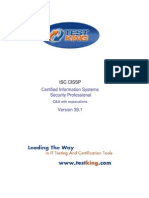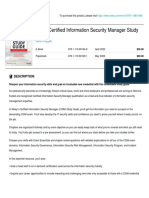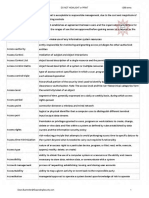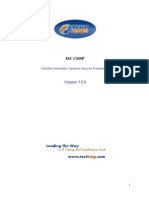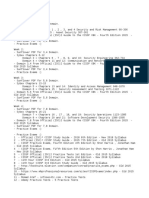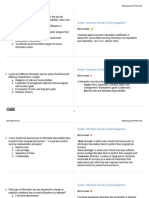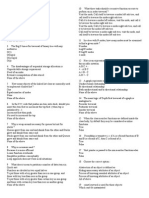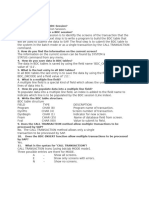CISSP Cheat Sheet Domain 80
CISSP Cheat Sheet Domain 80
Uploaded by
PremdeepakHulagbaliCopyright:
Available Formats
CISSP Cheat Sheet Domain 80
CISSP Cheat Sheet Domain 80
Uploaded by
PremdeepakHulagbaliOriginal Title
Copyright
Available Formats
Share this document
Did you find this document useful?
Is this content inappropriate?
Copyright:
Available Formats
CISSP Cheat Sheet Domain 80
CISSP Cheat Sheet Domain 80
Uploaded by
PremdeepakHulagbaliCopyright:
Available Formats
CISSP Cheat Sheet Series
Software Development Lifecycle (SDLC) Programming Language Types Data Warehousing and Data Mining Change Management Process
Understand and integrate security throughout the software development Machine Data Develop organizational framework where users can
Direct instructions to processor - binary representation Combine data from multiple sources. Request
lifecycle (SDLC) Languages Warehousing request modifications, conduct cost/ benefit analysis by
Control
Assembly Use of symbols, mnemonics to represent binary codes - Arrange the data into a format easier to make business management, and task prioritization by developers
Data Mining
Development Methodologies Language ADD, PUSH and POP decisions based on the content. Develop organizational framework where developers can
Change
Processor independent programming languages - use create and test a solution before implementation in a
• No key architecture design
• Problems fixed as they occur
High-Level
IF, THEN and ELSE statements as
Database Threats Control
production environment.
Build and fix Language
• No formal feedback cycle part of the code logic Aggregation The act of combining information from various sources. Release
Change approval before release
• Reactive not proactive Generation 4 languages further reduce amount of code Inference Process of information piecing Control
Very high-level
• Linear sequential lifecycle required - programmers can focus on algorithms. • Content Dependent Access Control: access is based on
• Each phase is completed before moving on
language
Python, C++, C# and Java Access the sensitivity of the data
Configuration Management Process
Waterfall
• No formal way to make changes during cycle Natural Generation 5 languages enable system to learn and Control • Context Dependent Access Control: access via Software Version A methodology for storing and tracking changes
• Project ends before collecting feedback and re-starting language change on its own - AI location, time of day, and previous access history. Control (SVC) to software
• Based on the waterfall model • Database Views: set of data a user or group can see Configuration The labelling of software and hardware
Access
V-shaped
• Each phase is complete before moving on Database Architecture and Models Control
• Database Locks: prevent simultaneous access Identification configurations with unique identifiers
• Verification and validation after each phase • Polyinstantiation: prevent data interference violations Verify modifications to software versions
Uses attributes (columns) and tuples (rows) to Mechanisms
• No risk analysis phase Relational Model in databases Configuration Control comply with the change control and
organize data
• Rapid prototyping - quick sample to test the current configuration management policies.
project Hierarchical Parent child structure. An object can have one child, A•C•I•D Ensure that the production environment is
• Evolutionary prototyping - incremental improvements to Model multiple children or no children. Configuration Audit
Database roll back if all operations are not completed, consistent with the accounting records
Prototyping Atomicity
a design Similar to hierarchical model but objects can have transactions must be completed or not completed at all
• Operational prototypes - incremental improvements Network Model
multiple parents. Consistency Preserve integrity by maintaining consistent transactions Capability Maturity Model
intended for production
Transaction keeps separate from other transactions until 1. Initiating – informal processes,
• Multiple cycles (~ multiple waterfalls) Object-Oriented Has the capability to handle a variety of data types Isolation Reactive
complete 2. Repeatable – project management processes
• Restart at any time as a different phase Model and is more dynamic than a relational database.
Incremental Durability Committed transaction cannot be roll backed 3. Defined – engineering processes, project planning,
• Easy to introduce new requirements
quality assurance, configuration management practices
• Delivers incremental updates to software Object-Relational Combination of object oriented and relational Traditional SDLC Proactive
4. Managed – product and process improvement
• Iterative Model models. 5. Optimizing – continuous process improvement
Analysis, High-level design, Detail Design, Construction,
• Risk analysis during development Steps
testing, Implementation
Spiral • Future information and requirements considered for risk Project Management Tools
analysis Database Interface Languages • Initiation: Feasibility, cost analysis, risk analysis,
• Allows for testing early in development Management approval, basic security controls Type of bar chart that illustrates the relationship
Gantt chart
Open Database • Functional analysis and planning: Requirement between projects and schedules over time.
Rapid • Rapid prototyping Local or remote communication via API
Connectivity (ODBC) definition, review proposed security controls Program Evaluation Project-scheduling tool used to measure the
Application • Designed for quick development
• System design specifications: detailed design specs, Review Technique capacity of a software product in development
Development • Analysis and design are quickly demonstrated Java Database Java API that connects to a database, Phases
Examine security controls (PERT) which uses to calculate risk.
(RAD) • Testing and requirements are often revisited Connectivity (JDBC) issuing queries and commands, etc • Software development: Coding. Unit testing Prototyping,
• Umbrella term - multiple methods
DB API allows XML applications to interact Verification, Validation Phases of object-oriented design
• Highlights efficiency and iterative development XML
Agile with more traditional databases • Acceptance testing and implementation: security OORA (Requirements
• User stories describe what a user does and why Define classes of objects and interactions
testing, data validation Analysis)
• Prototypes are filtered down to individual features Object Linking and
Embedding Database (OLE is a replacement for ODBC Object-oriented technology (OOT) - Identify classes and objects which are common
DevOps (Development & Operations) DB) OOA (Analysis) to any applications in a domain - process of
Terminology discovery
Software Development • Quality Assurance • IT
OOD (Design) Objects are instances of classes
Operations Knowledge Management Objects contain both data and the instructions that work
OOP (Programming) Introduce objects and methods
on the data.
Two main components: 'Knowledge base' and the ORBs (Object Request Work as middleware locators and distributors
Software Development Methods
Encapsulation Data stores as objects
'Inference engine' Brokers) for the objects
Message Informs an object to perform an action.
Expert • Use human reasoning Architecture and standards that use ORBS to
Performs an action on an object in response to a CORBA (Common
Systems • Rule based knowledge base Method allow different systems and software on a
Database Systems • If-then statements message. object request)
system to interfce with eachother
• Interference system Results shown by an object in response to a Work independently without help from other
Database Define storing and manipulating data message. Defined by its methods, which are the programs
Behavior
• Forward chaining: Begins with known facts and applies functions and subroutines defined within the object • High cohesion – No integration or interaction
DBMS (database inference rule to extract more data unit it reaches to the class. Cohesion with other modules
Software program control access to data stored
management goal. A bottom-up approach. Breadth-first search Set of methods which defines the behavior of • Low cohesion – Have interaction with other
in a database. Expert Class
system) strategy. objects modules
Systems (Two
• Backward chaining: Begins with the goal, works • Coupling - Level of interaction between objects
Modes) Object An instance of a class containing methods
Hierarchical • Network • Mesh • Object-orientated backward through inference rules to deduce the
DBMS Types Inheritance Subclass accesses methods of a superclass
• Relational required facts that support the goal. A top-down
approach. Depth-first search strategy. Multiple Inherits characteristics from more than one parent Virus Types
Data definition language defines structure and Inheritance class
DDL
schema DML Accumulates knowledge by observing events, Two or more rows in the same relational database Boot record infectors, gain the most privaleged
Boot sector
Neural measuring their inputs and outcome, then predicting Polyinstantiation table appear to have identical primary key elements access and can be the most damaging
Degree of Db number of attributes (columns) in table Networks outcomes and improving through multiple iterations but contain different data
over time. Infects executable system files, BIOS and system
Object users do not need to know the information System infector
Tuple row Abstraction commands
about how the object works
DDE Dynamic data exchange Covert Channels (Storage & Timing) Process isolation
Allocation of separate memory spaces for process’s UEFI Infects a system's factory installed UEFI (firmware)
instructions and data by the operating system.
DCL Data control language. Subset of SQL. Executable content Virus stored in a specific location other than in the
ActiveX controls, Java applets, browser scripts Companion
Mobile code Trusted Computer Base (TCB) main system folder. Example NOTEPAD.EXE
ensure semantic rules are enforced between data
Semantic integrity Virus Propagates with help from the host Any modifications to files or boot sector are hidden
types The set of all hardware, firmware, and/or software components that are Stealth
Worm Propagates without any help from the host by the virus
critical to its security. Any compromises here are critical to system
Referential integrity all foreign keys reference existing primary keys Logic Bomb/Code security.
Run when a specific event happens Multipart Infects both boot sector and executable files
Bomb
an attribute that is a unique identifier within a May need to interact with higher rings of
Input/output Attempts to hide from anti-virus by changing the
Candidate Key given table, one of the candidates key becomes Buffer Overflow Memory buffer exhaustion protection - such communications must be Self-garbling
operations encoding of its own code, a.k.a. 'garbling'
primary key and others are alternate keys Malicious code install at back end with the monitored
Backdoor
help of a front end user Execution domain Applications that invoke applications or Polymorphic The virus modifies the "garble" pattern as it spreads
Primary Key unique data identification
Covert Channel Unauthorized information gathering switching services in other domains
Resident Loads as and when a program loads to the memory
reference to another table which include primary Zombie code used to compromise thousands Monitoring of memory references to verify
Foreign Key key. Foreign and primary keys link is known as Botnet Memory protection Master boot
of systems confidentiality and integrity in storage
referential integrity. record / sector Infects the bootable section of the system
Malicious code that outwardly looks or Monitor registers, process status information, (MBR)
Trojan Process activation
behaves as harmless or necesary code and file access lists for vulnerabilities
• Incorrect Summaries • Dirty Reads • Lost
Updates Security Assessment & Testing Terms Anti-Virus Types
• Dynamic Lifetime Objects: Objects developed Browser site trust is exploited by trying to
Cross-site request A process of identifying and determining the Not able to detect new malware a.k.a. Zero-day
using software in an Object Oriented submit authenticated requests forcefully to Penetration Testing Signature based
forgery (CSRF / XSRF ) true nature if system vulnerabilities attacks
Programming environment. third-party sites.
• ODBC - Open Database Connectivity. Database Heuristic based Static analysis without relying on signatures
Cross-site scripting Uses inputs to pretend a user’s browser to Patch management Manages the deployment of patches to
feature where applications to communicate with
(XSS) execute untrusted code from a trusted site system prevent known attack vectors
different types of databases without a program
DBMS terms Attempts to obtain previously authenticated
code.
• Database contamination - Mixing data with
Session Hijacking sessions without forcing browser requests Open system
System with published APIs - third parties can Protection Rings
use system
submission
different classification levels
Proprietary system - no third-party Layer 0 Operating system kernel
• Database partitioning - splitting a single SQL Injection Directly attacks a database through a web app Closed system
database into multiple parts with unique contents involvement
Layer 1 Parts of the operating system other than the kernel
• Polyinstantiation - two or more rows in the same Hotfix / Update / Updates to operating systems and Source code can be viewed, edited and
Open-source
relational database table appear to have identical Security fix applications distributed free or with attribution or fees
Layer 2 I/O drivers and utilities
primary key and different data in the table. Collection of patches for a complete operating Used to access API. Highly sensitive - same
Service Pack API Keys
system as passwords Layer 3 Applications and programs
You might also like
- CISA – Certified Information Systems Auditor Study Guide: Achieve CISA certification with practical examples and over 850 exam-oriented practice questionsFrom EverandCISA – Certified Information Systems Auditor Study Guide: Achieve CISA certification with practical examples and over 850 exam-oriented practice questionsNo ratings yet
- CISSP Cheat Sheet Domain 1-2Document1 pageCISSP Cheat Sheet Domain 1-2Xaxtsu LungNo ratings yet
- CGRC Ultimate Guide RBDocument15 pagesCGRC Ultimate Guide RBWilliam OgahNo ratings yet
- CISSP Cheat Sheet Domain 3Document1 pageCISSP Cheat Sheet Domain 3PremdeepakHulagbaliNo ratings yet
- 022 Thor-Teaches-study-guide-CISSP-domain-2 - (FreeCourseWeb - Com)Document7 pages022 Thor-Teaches-study-guide-CISSP-domain-2 - (FreeCourseWeb - Com)LinuxPower100% (2)
- TK-CISSP.v39.1 1451qDocument654 pagesTK-CISSP.v39.1 1451qnsireeshkumar50% (4)
- Cisa Practice Question Database V14Document7 pagesCisa Practice Question Database V14Tina Park0% (3)
- CISA - Domain 3 - IS Acquisition, Development and ImplementationDocument153 pagesCISA - Domain 3 - IS Acquisition, Development and ImplementationPremdeepakHulagbali100% (2)
- CISA - Domain 0 - Introduction To CISADocument11 pagesCISA - Domain 0 - Introduction To CISAPremdeepakHulagbali100% (1)
- CISM Certified Information Security Manager Study Guide: DescriptionDocument2 pagesCISM Certified Information Security Manager Study Guide: DescriptionTiago Tadeu de Oliveira0% (1)
- CISSP Whole Glossary2021Document64 pagesCISSP Whole Glossary2021babuNo ratings yet
- CISSP Cheat Sheet Domain 4 PDFDocument1 pageCISSP Cheat Sheet Domain 4 PDFXloverNo ratings yet
- Cissp Step by Step GuideDocument1 pageCissp Step by Step GuideKady YadavNo ratings yet
- Structured Cyber Security CISSP BrainmapsDocument50 pagesStructured Cyber Security CISSP BrainmapsHaseeb Nasir AliNo ratings yet
- Cissp - Issmp Exam OutlineDocument33 pagesCissp - Issmp Exam OutlinehumdilNo ratings yet
- CISM Course OutlineDocument6 pagesCISM Course OutlineAnonymous k9IQtin0% (1)
- SSCP / Cissp Notes I Used To PassDocument43 pagesSSCP / Cissp Notes I Used To Passpsudharsan100% (6)
- Qualys Multi-Vector EDR: Lab Tutorial SupplementDocument24 pagesQualys Multi-Vector EDR: Lab Tutorial SupplementPremdeepakHulagbaliNo ratings yet
- CISA - Domain 5 - Protection of Information AssetsDocument202 pagesCISA - Domain 5 - Protection of Information AssetsPremdeepakHulagbali100% (1)
- CISA - Domain 2 - Governance and Management of ITDocument98 pagesCISA - Domain 2 - Governance and Management of ITPremdeepakHulagbali100% (1)
- Course Overview: This Course Provides In-Depth Coverage of The Eight Domains Required To Pass The CISSP ExamDocument30 pagesCourse Overview: This Course Provides In-Depth Coverage of The Eight Domains Required To Pass The CISSP ExamAbdul GhaffarNo ratings yet
- ThorTeaches CISSP Study Plan 2021Document8 pagesThorTeaches CISSP Study Plan 2021calves3437No ratings yet
- CISSP Cheat Sheet Domain 5 PDFDocument1 pageCISSP Cheat Sheet Domain 5 PDFXlover100% (1)
- CISSP Combined NotesDocument59 pagesCISSP Combined NotesAnonymous 9d1jFv100% (5)
- CisspDocument286 pagesCissphn_hvt75% (4)
- Cissp WeekDocument159 pagesCissp Weekrcb023100% (1)
- CISSP Referenced The Reddit Forum WeeklyDocument2 pagesCISSP Referenced The Reddit Forum WeeklySakil MahmudNo ratings yet
- CISSP MindMap - 1Document1 pageCISSP MindMap - 1testerNo ratings yet
- Auerbach The Total CISSP Exam Prep Book Practice Questions Answers and Test Taking Tips and Techniques PDFDocument277 pagesAuerbach The Total CISSP Exam Prep Book Practice Questions Answers and Test Taking Tips and Techniques PDFIon VladNo ratings yet
- MindCert CISSP Physical Security MindMapDocument1 pageMindCert CISSP Physical Security MindMapbesmart2000100% (1)
- CISSP Practice Exam QuestionsDocument55 pagesCISSP Practice Exam QuestionsDoris InmanNo ratings yet
- Thor Teaches Study Guide CISSP Domain 6Document11 pagesThor Teaches Study Guide CISSP Domain 6babyNo ratings yet
- CISSP Cheat Sheet Domain 2-2 PDFDocument1 pageCISSP Cheat Sheet Domain 2-2 PDFnjNo ratings yet
- Studying For The Cism Exam3Document6 pagesStudying For The Cism Exam3book checkerNo ratings yet
- Isaca Cisa CismDocument49 pagesIsaca Cisa CismKavithaRamchandran100% (1)
- Cissp: The 8 Domains of CISSPDocument52 pagesCissp: The 8 Domains of CISSPLacky KrishnanNo ratings yet
- CISSP Preparation StepsDocument2 pagesCISSP Preparation StepsDavid Williams100% (1)
- Key Tables, Charts and Flows For SSCP - CISSPDocument45 pagesKey Tables, Charts and Flows For SSCP - CISSPKevin HuangNo ratings yet
- Cissp Information PDFDocument4 pagesCissp Information PDFZaheer BkNo ratings yet
- CisspDocument16 pagesCisspRyan GlasgowNo ratings yet
- CISA Practice Questions To Prep For The ExamDocument14 pagesCISA Practice Questions To Prep For The ExamAntar ShaddadNo ratings yet
- Preparation Guide CISSPDocument104 pagesPreparation Guide CISSPMuthiani Muoka100% (1)
- 4 Weeks PlanDocument2 pages4 Weeks PlanChrisNo ratings yet
- 0-CISSP Flash Cards Draft 6-6-2010Document126 pages0-CISSP Flash Cards Draft 6-6-2010Maurício SilvaNo ratings yet
- Certifications PathwaysDocument2 pagesCertifications PathwaysAlexis Sebastian Alarcon CamposNo ratings yet
- Cissp Exam: Certified Information Systems Security Professional Questions & Answers DemoDocument3 pagesCissp Exam: Certified Information Systems Security Professional Questions & Answers DemoGopikrishna PanduranganNo ratings yet
- CISSP Study NotesDocument11 pagesCISSP Study NotesCISSPInspired100% (1)
- 300+ (UPDATED) CISSP MCQs and Answers (PDF)Document25 pages300+ (UPDATED) CISSP MCQs and Answers (PDF)Pierre-Marie Diambra0% (1)
- ThorTeaches CISA Study PlanDocument4 pagesThorTeaches CISA Study PlanRobo RoboNo ratings yet
- CISSP - Domain 5Document51 pagesCISSP - Domain 5ezechrissNo ratings yet
- Memorization SheetDocument6 pagesMemorization SheetEdward Holder100% (1)
- CISSP NoteDocument62 pagesCISSP NoteLe An75% (4)
- Module 1: Security Management: Lesson 1: Confidentiality, Integrity, and AvailabilityDocument7 pagesModule 1: Security Management: Lesson 1: Confidentiality, Integrity, and AvailabilityAntonio BrandãoNo ratings yet
- How To Crack The CISSPDocument3 pagesHow To Crack The CISSPSayed Ashraf Husaini KaziNo ratings yet
- Cissp e BookDocument1,099 pagesCissp e Bookrishshris100% (1)
- MindCert CISSP Access Control MindMap PDFDocument1 pageMindCert CISSP Access Control MindMap PDFZeeshan RanaNo ratings yet
- Study Notes and Theory - BCP and DRPDocument4 pagesStudy Notes and Theory - BCP and DRPuwb_groupNo ratings yet
- GIAC Certified Project Manager A Clear and Concise ReferenceFrom EverandGIAC Certified Project Manager A Clear and Concise ReferenceNo ratings yet
- Cissp - Domain 7 HandoutDocument78 pagesCissp - Domain 7 HandoutYogendra Singh NegiNo ratings yet
- Cisa SummaryDocument20 pagesCisa SummaryYan ForteNo ratings yet
- My Cissp Success Journey: (Lalit Kumar, CISSP, CISA, ISO 27001 LA, CEH, ITIL, DBA, System Admin)Document2 pagesMy Cissp Success Journey: (Lalit Kumar, CISSP, CISA, ISO 27001 LA, CEH, ITIL, DBA, System Admin)Abdul MalikNo ratings yet
- CISSP Exam Tips InfoSecDocument12 pagesCISSP Exam Tips InfoSecAdnan ZafarNo ratings yet
- GIAC Certified Perimeter Protection Analyst Complete Self-Assessment GuideFrom EverandGIAC Certified Perimeter Protection Analyst Complete Self-Assessment GuideNo ratings yet
- CISSP Models Process Frameworks HandoutDocument82 pagesCISSP Models Process Frameworks HandoutPremdeepakHulagbali0% (1)
- CISS Exam Cram - Think Like A ManagerDocument40 pagesCISS Exam Cram - Think Like A ManagerPremdeepakHulagbali0% (1)
- CISSP - Cryptography Drill-Down HandoutDocument43 pagesCISSP - Cryptography Drill-Down HandoutPremdeepakHulagbaliNo ratings yet
- EDR QSC2020 SlidesDocument120 pagesEDR QSC2020 SlidesPremdeepakHulagbaliNo ratings yet
- Isc2 Exam1pass Cissp v2013-01-10 by Exam1pa12ssDocument44 pagesIsc2 Exam1pass Cissp v2013-01-10 by Exam1pa12ssPremdeepakHulagbaliNo ratings yet
- CISA - Domain 1 - Process of Auditing Information SystemsDocument87 pagesCISA - Domain 1 - Process of Auditing Information SystemsPremdeepakHulagbali100% (2)
- MCA (Revised) Term-End Examination December, 2009 Mcs-024: Object Oriented Technologies and Java ProgrammingDocument2 pagesMCA (Revised) Term-End Examination December, 2009 Mcs-024: Object Oriented Technologies and Java ProgrammingNitin NileshNo ratings yet
- Accenture Test Paper - 3Document10 pagesAccenture Test Paper - 3Raksana N MNo ratings yet
- Quiz FinalDocument25 pagesQuiz FinalBảo Kim GiaNo ratings yet
- Abstract Classes in PHPDocument5 pagesAbstract Classes in PHPshijinbgopalNo ratings yet
- Design PatternsDocument306 pagesDesign PatternschavsNo ratings yet
- Cse357 MCQDocument28 pagesCse357 MCQsharma32511.psNo ratings yet
- Relational Databases and BeyondDocument12 pagesRelational Databases and BeyondaNo ratings yet
- Midlands State University: Faculty of Science and Technology Department of Computer Science and Information SystemsDocument27 pagesMidlands State University: Faculty of Science and Technology Department of Computer Science and Information Systemselyon kativuNo ratings yet
- Java Pra FileDocument18 pagesJava Pra Filesantosh srivastavaNo ratings yet
- Digicoders Technologies Private Limited, Lucknow: Summer Training ReportDocument42 pagesDigicoders Technologies Private Limited, Lucknow: Summer Training ReportPrachi MishraNo ratings yet
- Object Oriented Programming 3Document18 pagesObject Oriented Programming 3rahul rastogiNo ratings yet
- OOP Inheritance & Polymorphism - Java Programming TutorialDocument45 pagesOOP Inheritance & Polymorphism - Java Programming TutorialHuyền Trang Trần NguyễnNo ratings yet
- System Verilog Interview QuestionsDocument8 pagesSystem Verilog Interview Questionsramthaku18No ratings yet
- Oops Detailed NotesDocument8 pagesOops Detailed NotesKiaraNo ratings yet
- Methods & ClassesDocument38 pagesMethods & ClassesAli MattrNo ratings yet
- Lecture 14 - Dynamic Method DispatchDocument11 pagesLecture 14 - Dynamic Method DispatchThe PriestNo ratings yet
- Describing Web Resources in RDF: Grigoris Antoniou Frank Van HarmelenDocument120 pagesDescribing Web Resources in RDF: Grigoris Antoniou Frank Van HarmelenIshank KumarNo ratings yet
- Inheritance Vs CompositionDocument3 pagesInheritance Vs CompositionFLORIST PALACENo ratings yet
- Diagnostic Test - Programming JavaDocument5 pagesDiagnostic Test - Programming JavaFernan EnadNo ratings yet
- How Should Classes Be Initialized?: Juanita J. Ewing Instantiations, IncDocument6 pagesHow Should Classes Be Initialized?: Juanita J. Ewing Instantiations, InchectorjazzNo ratings yet
- Short Questions OopjDocument19 pagesShort Questions OopjRK HUSSAINNo ratings yet
- Kamandi - OOMetricsDocument28 pagesKamandi - OOMetricsmadhukedarNo ratings yet
- ATM Case Study Code-JavaDocument9 pagesATM Case Study Code-JavaRithika M Nagendiran100% (1)
- Unit 2 OopsDocument49 pagesUnit 2 OopsRobert LoitongbamNo ratings yet
- P10 - C++Document5 pagesP10 - C++Rohit KshirsagarNo ratings yet
- VB MCQDocument17 pagesVB MCQabrarNo ratings yet
- Subject Code CS-305: (Object Oriented Programming & Methodology)Document33 pagesSubject Code CS-305: (Object Oriented Programming & Methodology)poorvaNo ratings yet
- Advance PHP1Document201 pagesAdvance PHP1Vanshika PatelNo ratings yet
- 7 RICEFW Interview Questions2311Document24 pages7 RICEFW Interview Questions2311Mayank HajareNo ratings yet
- Mumbai University Sem III-IV Electronics and Telecommunication EnggDocument49 pagesMumbai University Sem III-IV Electronics and Telecommunication EnggAbhijit SomnatheNo ratings yet





